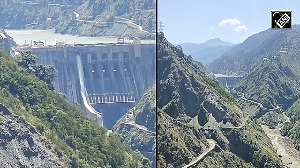 Lakshmi Mittal, Chairman, Mittal Steel, says that India is a market of particular opportunity on the basis of its large population and current low per capita steel consumption, provided that the country pushes forward with its economic reform.
Lakshmi Mittal, Chairman, Mittal Steel, says that India is a market of particular opportunity on the basis of its large population and current low per capita steel consumption, provided that the country pushes forward with its economic reform.
Speaking at the World Steel Dynamics Annual Steel Success Strategies Conference in New York on Tuesday, Mittal also said that he was now less concerned that the Chinese industry is a threat having witnessed the Chinese government's stringent control on capacity increase.
Following is the entire text of his speech:
Ladies and Gentlemen,
I am delighted to be here with you today in New York for this year's Steel Success Strategies Conference.
The last time I addressed this conference was in 1999 when I received the Willy Korf Steel Vision award. At that time we were only a twenty million ton producer, but it was very encouraging to receive the award in recognition of our vision for global consolidation and the steps we had taken to achieve this.
Only six years later and we have made considerable progress in turning this vision into a reality, although funnily enough I don't seem to have received any more awards in recognition of our achievements. Maybe Peter and Karlis don't think we have made enough progress yet!
I would however like to take this opportunity to offer my congratulations to Madam Xie who is this year's recipient of the award. Her achievements at Bao Steel are considerable and I expect that we will continue to see this company playing a major role in the future developments of the steel industry.
This conference seems to attract more and more attendees every year -- so much so that this year we have had to move to a bigger venue -- and this is very encouraging to see. It is not only a testament to the hard work of Peter and Karlis, but also to the more favourable position the industry enjoys today as a result of the positive steps we have taken to restructure and move towards becoming a more sustainable industry.
It is this issue of sustainability that I would like to focus on in my speech to you today. I think that everyone here would agree that the steel industry has proved in 2004 that it has the potential and ability to create considerable value. Many steel companies posted record results.
However despite this value creation, the industry continues to trade at a significant discount to other basic materials -- with earnings multiples still only in the region of five to six times. From this it is clear that the financial community is yet to be fully convinced that the industry really has the ability to break away from its past volatility and provide value through the cycles.
We believe that this is a real possibility and that steel producers now have the opportunity to create an attractive and sustainable industry in the 21st century.
There have been two fundamental changes in the industry's dynamics in recent years. Firstly, global demand has entered a new growth era, largely driven by China's industrialisation. Secondly significant consolidation has occurred, leading to a stronger industry.
In terms of growth, it is clear that China's industrialisation has brought a new dynamic to the steel industry, but it has been the growth over the last three years, driven by the implementation of new economic policies, which has had a dramatic effect with the market virtually doubling from 150 million tonnes to 300 million tonnes.
The increased demand in China has resulted in the global market growing by an average of 5 per cent since the early 70s. The question that now needs addressing is, "Is this growth sustainable?"
Given that the average steel consumption per capita in China is still approximately 200 kg reaching 500 kg in the coastal areas as compared with 700 kg in Japan and nearly 900 kg in Taiwan and Korea it would be logical to expect the Chinese demand to continue to grow strongly over the next 3 to 5 years.
However my initial concerns that China would become a net exporter given the rapid expansion they were building in their own capacity are now abating somewhat having witnessed the Chinese government's stringent control regarding capacity increase.
The regulation on the industry to both slow down the growth of new capacity as well as cull the industry of sub-scale, long-term inefficient plants and the recent decision to abolish export tax rebates on semi-finished products is an example.
Secondly, dependency on iron-ore imports, high energy costs, environmental constraints and an inland industrial network are all structural disadvantages. Although the Chinese labour cost advantage in 2004 was as high as $100 per tonne, hot metal costs averaged just $55 lower than North America and Europe.
Thus it is difficult therefore to envisage China becoming a natural exporter of steel, particularly as their current labour cost advantage will lessen over time.
In terms of driving future demand growth, India represents an opportunity for the steel industry on the basis of its large population and current low per capita consumption. With a population of approximately one billion people, India consumed only around 32 million tonnes of steel in 2004 which equals less than 30 kg per person.
The growth opportunity is certainly there. However the extent to which India can emulate the growth pattern of China and more specifically over what timescale is yet to be determined.
I have long believed that India has the potential to become one of the world's major economic forces, and that to do so the country must continuously monitor its progress against both other fast growing economies and the major economies to which it aspires.
Good progress is being made and GDP growth has been stepped up significantly in recent years, now within sight of achieving the goal of 8 per cent growth.
However the pace at which this transformation is occurring needs to be accelerated and the government needs to commit resources and energy into industrialisation and building the infrastructure. Provided such economic reform can be implemented there is a strong possibility for India to continue to drive global steel demand growth.
Similarly there is also opportunity for growth in the other two "BRIC" countries, Brazil and Russia. This potential is not to the same scale as China or India, but collectively these four countries, with a combined population of some 2.7 billion and fast-growing economies, will represent a large source of GDP driven growth in steel demand in the future.
Provided the economies of these countries continue to develop at the anticipated growth rates, demand growth for the steel industry has the potential to continue at around 3 to 4 per cent over the foreseeable future.
Although undeniably a positive dynamic, demand growth alone does not equal sustainability. However it does provide us with a fundamental positive basis from which to work to realise a healthier industry which can create value through the cycles.
Cyclicality in the steel industry will never disappear in its entirety. Nevertheless it can, and should, be reduced. Cyclicality in the steel industry has been a direct consequence of the dynamics of supply lagging demand and vice-versa, the result being severe price volatility.
The major trend that will help address cyclicality is not management of the underlying demand, but management of the industry's supply chain.
Today's softening of the market is not due to a sudden drop in demand but due to an inventory overhang situation created in the market. In the third and the fourth quarter of 2004, due to strong market sentiments and concerns about supply, customers procured more than their actual requirements.
Given that the demand has remained the same, these customers are now liquidating their excess inventory upsetting the equilibrium between demand and supply. This is the main reason for the softening of the market and this situation will correct itself as soon as this equilibrium is reached.
This situation can be better dealt with through consolidation of the industry. Consolidation will lead to companies adjusting production levels to ensure that the inventory corrects itself and the state of equilibrium is re-established.
Thus if we as an industry can understand this phenomena we will be able to build more sustainability in our operations. It is heartening to note that the industry has already started taking steps in this direction with countries like Ukraine, Russia and China cutting production to ensure that the current situation is tidied over soon.
You only have to look at the average operating margins of other industries to see that consolidation helps create sustainable margins. The iron-ore industry for example, where 3 major players have nearly three quarters of total market share, has average margins of 35 per cent. In comparison, average reported margins in the steel industry over the past five years, where the top ten producers have only around a quarter of global market share, are nearer 10 per cent.
Consolidation in the steel industry is now underway and I have long been an advocate of the benefits this will bring. None of us would wish to experience the market scenario of 2001 again, but in hindsight the severity of the downturn acted as a valuable catalyst in terms of forcing steel companies to start thinking about consolidating. In many cases it was their only opportunity for survival.
Comparing total steel production of the top ten producers in 2004 with 1993 is a good illustration of the progress in consolidation. In 1993 the top ten producers comprised only around 150 million tonnes. Over the past ten years that has doubled to approximately 300 million tonnes.
To date this consolidation has largely been in the developed markets. Consolidation in both North America and Europe for example is fairly well advanced. In North America, 60 per cent of production is supplied by the top five companies.
The same is true in Europe. This is not to say consolidation is completed in these markets. There will be further opportunities, but the levels of consolidation that have been achieved are already helping promote a much healthier operating environment.
The visible benefits of this consolidation has been seen in recent months with most of the United States and European producers analysing supply/demand in the market and responding to the inventory build-ups in these markets by temporarily cutting production. This is a rational market-oriented reaction and one which we had not seen five years ago.
The consolidation trend has taken place on three continents, but to date it has largely been regionally driven. What needs to happen now is more global consolidation.
Mittal Steel has always believed that a global business model is logical for the steel industry. In the flat market particularly, our customer base is global and we need to be in a position where we can offer them product solutions globally, not just in one region.
Mittal Steel's own growth has very much been in line with this belief and indeed our merger with ISG was hailed as the first major inter-continental deal in the steel industry. I think this will continue to be a trend in the future, and several other steel companies have spoken of their desire to become global companies.
I do believe that this will occur and indeed it is vital for the industry.
For global consolidation to really accelerate, there will also need to be an end to the nationalistic feelings that have historically dominated the steel industry. But history has proved that governments do not necessarily make the best owners of business.
Having participated in fifteen privatisations, Mittal Steel has first hand experience of the benefits that privatisation brings to steel companies. With the right strategic direction and investment, they are reinventing themselves as profitable and sustainable entities with a very bright future. I would urge countries which have not yet embraced privatisation of the steel industry to press ahead with such reform and have confidence that it will bring many benefits to the country and its economy.
Consolidation will be key to building a sustainable model for the steel industry, but it alone will not resolve our historical problems. Consolidation will help the industry to better manage supply and demand, but a change in management style and thinking and a more market focussed approach is also required.
Stability and steadiness in the business world and in the industry needs to be practised by the industry, its suppliers and buyers.
Productivity will also be crucial and management teams must work towards reaching the optimum in terms of productivity. The unions also play an important role to this regard and I would like to take this opportunity to congratulate Leo Gerard, President USWA, who we heard from this morning, on the considerable part he has played in working with steel companies to ensure the long-term sustainability of the North American steel industry.
As these arguments indicate, I do believe that the foundation now exists for the steel industry to create a sustainable business model that should over time lead to a re-rating of our sector. The basic fundamentals are essentially positive. Demand growth is consistently higher than it has been for years and is expected to remain this way.
The market has embraced consolidation and regions such as Europe and the US are now well advanced in this area. A new type of management team is emerging which is profit-oriented and not production driven.
Yet despite this progress many of our stakeholders are yet to be convinced. In an investor conference recently where one fund manager stated that he believed steel stocks were still only there "to rent" and not "to buy".
This is a common perception and one which is understandable given the historic performance and behaviour of the sector. As an industry, we now must work hard to prove this should no longer be the case. In order to attract long-term investors, we need to convince them we have the potential to create long-term value.
In order to do this we must continue to push ahead with consolidation through all aspects of the cycle, not just on a regional but also on a global basis. I believe that the top ten producers should comprise at least forty percent of total market share. Management decisions must be driven by long-term sustainability and not short-term profitability or demand.
Those of you who attended the Paris Conference in 2003 will remember I talked about my vision of having a handful of truly global players accounting for 80 -- 100 million tonnes each, with a footprint in all the major regions. At the time the largest steel producer was 40 million tonnes. Now only a year and a half later, Mittal Steel is already nearly 60 million tonnes.
I also spoke of steel companies following a more integrated business model. This is particularly pertinent given the massive increases in iron-ore prices steel companies have been subject to over the past year. A greater certainty of input costs will also help build a more sustainable model.
Delivering on this will undoubtedly lead to the creation of a more attractive industry. We will always be cyclical to some extent but the cycles should be longer and flatter. The image of our industry would in turn change to that of a sustainable industry, managed for value by a set of truly world-class blue chip companies, adding value to our customers and creating wealth for our shareholders and the communities in which we operate.
An enhanced image would in turn attract talented managers and engineers into the industry, leading to a virtuous cycle culminating in a sustainable steel industry for the 21st century. I am confident that with the right approach and commitment this can be achieved.
Thank you very much.







 © 2025
© 2025